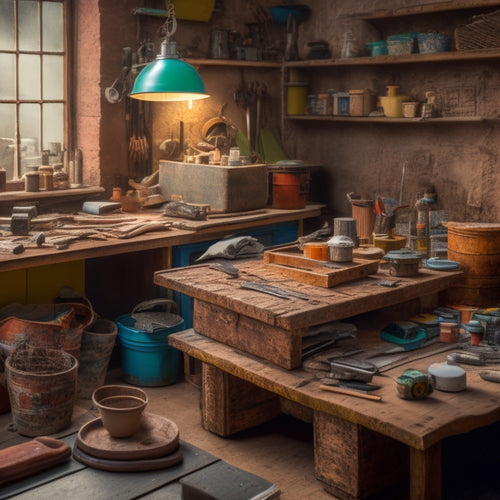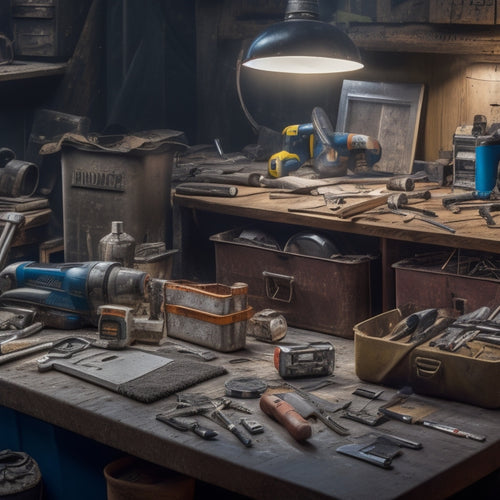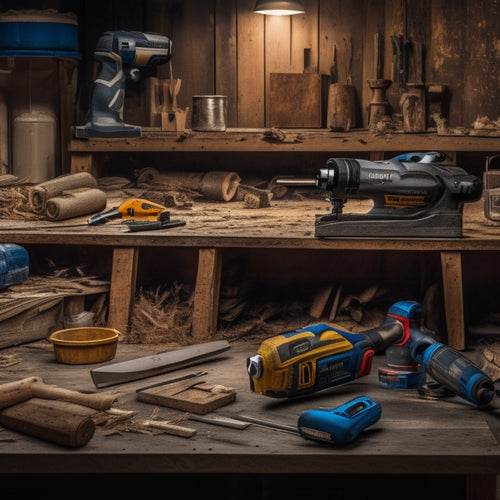
Top Tools for Safe Home Renovation Success
Share
As you prepare for your home renovation project, prioritize safety with the right tools and gear. Start with essential safety gear like gloves, safety glasses, and dust masks for concrete work, and invest in hard hats, dust masks, and fall protection equipment for demolition and elevated tasks. Don't forget heavy lifting aids, noise reduction tools, and dust control systems to minimize risks and discomfort. By incorporating these top tools into your renovation process, you'll be well on your way to a successful, injury-free project. As you get started, you'll discover even more ways to safeguard your health, property, and peace of mind.
Key Takeaways
• Invest in concrete safety gear, including gloves, safety glasses, and dust masks, to protect against abrasive and caustic concrete.
• Wear demolition protective equipment, such as hard hats and dust masks, to safeguard against falling objects and airborne contaminants.
• Utilize fall protection essentials, including proper harnesses and guardrails, to prevent accidents when working at heights.
• Implement noise reduction tools and machines, like acoustic panels and soundproof curtains, to minimize excessive sound and health hazards.
• Prioritize dust control systems with advanced filtration, including HEPA filters, to maintain air quality and prevent health risks during renovations.
Essential Safety Gear for Concrete
When working with concrete, wearing the right safety gear is vital, as the abrasive and caustic nature of this material can cause serious injuries to your skin, eyes, and respiratory system.
You don't want to risk compromising your health, especially when you're investing time and effort into a home renovation project. Make certain you wear gloves, safety glasses, and a dust mask to protect yourself from concrete's harsh effects. Additionally, wear long sleeves, pants, and closed-toe shoes to prevent skin exposure.
Before starting your project, confirm you've prepared the surface properly. This involves cleaning the area, removing any debris, and applying a bonding agent to create a strong bond between the old and new concrete.
Proper surface preparation is vital for effective concrete curing, which is critical for achieving the desired strength and durability. By taking these precautions, you'll be able to work with concrete safely and efficiently, confirming a successful home renovation project.
Best Concrete Mix for Renovation
With your safety gear in place and the surface properly prepared, you're now ready to select the best concrete mix for your renovation project. The right choice will depend on the specific requirements of your job.
For instance, if you're working on a foundation, you'll need a high-strength mix with a low water-to-cement ratio to guarantee maximum durability. On the other hand, if you're resurfacing a patio, a lower-strength mix with added color or texture might be more suitable.
When it comes to mixing techniques, following best practices is essential. Make sure to follow the manufacturer's instructions for the correct water-to-cement ratio, and mix the ingredients in the right order to avoid segregation.
You should also consider using a mixing stick or drill with a mixing paddle to guarantee a consistent blend. Additionally, be mindful of the temperature and humidity on the job site, as these factors can affect the concrete's curing process.
Protective Equipment for Demolition
When you're tackling a demolition project, you're not just dealing with hammers and saws - you're dealing with flying debris, toxic particles, and other hazards.
To guarantee you emerge from the chaos unscathed, you need to gear up with the right protective equipment.
In this section, you'll learn about the must-haves, including hard hat requirements and dust mask essentials, to keep you safe and focused on the task at hand.
Hard Hat Requirements
You'll need to wear a hard hat that meets the Occupational Safety and Health Administration's (OSHA) rigorous standards for protective equipment during demolition, as even a small falling object can cause serious head injuries. Hard hat regulations are in place to guarantee your safety, and it's crucial to choose the right type of hard hat for your project.
Here's a breakdown of the different hard hat types and their features:
| Hard Hat Type | Features | Use Cases |
|---|---|---|
| Type I | Protects top of head only | General construction, renovation |
| Type II | Protects top and sides of head | Heavy demolition, high-risk areas |
| Class C | Conductive, no electrical protection | Areas with no electrical hazards |
| Class E | Electrical protection, up to 20,000 volts | Areas with electrical hazards |
When selecting a hard hat, consider the specific hazards present in your demolition area and choose a hat that meets those needs. Remember, a hard hat is a critical piece of protective equipment, and wearing one that meets OSHA standards can mean the difference between a safe renovation and a serious injury.
Dust Mask Essentials
As you navigate the dusty terrain of demolition, a reliable dust mask becomes your shield against airborne contaminants, ensuring you can breathe easy and focus on the task at hand. You don't want to compromise your health, and a good dust mask is vital to protecting your lungs from harmful particles.
When choosing a dust mask, opt for N95 respirators, which filter out at least 95% of airborne particles. These respirators are designed to capture 99.97% of particles as small as 0.3 microns, providing superior protection against dust, debris, and other contaminants.
Particulate filters are also an important feature to look for in a dust mask. These filters trap particles, preventing them from entering your airways. Look for a dust mask with a filter that's specifically designed to capture the types of particles you'll encounter during demolition, such as wood dust, drywall dust, or asbestos.
Dust Control Systems for Safety
Every home renovation project generates massive amounts of dust, which can pose serious health risks and damage your property. This makes a reliable dust control system vital for a safe and successful renovation. You can't afford to compromise on air quality, so it's important to invest in a high-quality dust control system. A good system won't only protect your health but also prevent damage to your property and belongings.
When it comes to choosing a dust control system, look for one with advanced filtration systems that can capture even the smallest particles. You'll want a system that can handle high volumes of dust and debris, and one that's easy to set up and maintain.
Consider a system with multiple stages of filtration, including HEPA filters, to guarantee maximum air quality. By investing in a reliable dust control system, you'll be able to breathe easy knowing you're protected from the harmful effects of dust and debris.
Don't take chances with your health and property – prioritize a high-quality dust control system for a safe and successful renovation.
Heavy Lifting Aids and Accessories
Heavy lifting aids and accessories are essential tools for any home renovation project, helping to prevent injuries and reduce the physical strain associated with manual labor.
You'll be surprised at how much easier it is to move heavy materials around with the right equipment. Lifting straps, for instance, can distribute the weight of heavy objects more evenly, making them easier to lift and maneuver. Dollies and carts are also must-haves, allowing you to transport heavy loads with minimal effort. These tools are especially useful when working with heavy materials like lumber, drywall, or appliances.
When choosing heavy lifting aids and accessories, consider the weight capacity and durability of the equipment. You want to verify that your tools can handle the demands of your project.
Additionally, look for products with ergonomic designs that reduce strain on your back and joints. By investing in the right heavy lifting aids and accessories, you'll be able to work more efficiently and safely, reducing the risk of injury and fatigue.
With these tools, you'll be able to tackle even the most challenging renovation tasks with confidence and precision.
Noise Reduction Tools and Machines
You'll likely encounter noisy power tools and machinery on your home renovation journey, but with the right noise reduction tools and machines, you can minimize the din and create a more comfortable working environment.
Excessive noise can be distracting, stressful, and even hazardous to your health. Fortunately, there are many effective solutions available to help you reduce noise levels.
Here are some essential noise reduction tools and machines to take into account:
-
Acoustic Panels: These specially designed panels absorb sound waves, reducing echo and reverberation. They're especially useful in rooms with hardwood or tile floors, where sound tends to bounce around.
-
Soundproof Curtains: These thick, heavy curtains can be hung on walls or ceilings to block sound waves from escaping or entering. They're perfect for creating a quiet workspace or reducing noise pollution in shared living spaces.
-
Noise-Cancelling Headphones: When working with loud power tools, noise-cancelling headphones can be a lifesaver. They help block out external noise, allowing you to focus on the task at hand.
Fall Protection for Elevated Work
As you move on to tackle tasks that require working at heights, it's vital to prioritize fall protection to secure your safety and prevent accidents. You don't want to take any chances when working on ladders, scaffolding, or roofs. That's why investing in proper fall protection equipment is essential.
First, confirm you've got a solid guardrail installation in place. This will provide a physical barrier to prevent falls and give you peace of mind while working at heights.
Next, focus on your personal protective equipment (PPE). Conduct regular harness inspections to verify it's in good condition and functioning correctly. Don't skip this step – a faulty harness can be a recipe for disaster.
Additionally, make sure you're properly trained on how to use your fall protection gear. Understand how to correctly wear your harness, and know the proper procedures for rescue and retrieval in case of an emergency.
Frequently Asked Questions
What Are the Consequences of Not Wearing Protective Gear During Renovation?
When you don't wear protective gear during renovation, you're putting yourself at serious risk.
You're exposing yourself to health risks that can have long-term consequences, from respiratory problems to vision loss.
Without proper gear, you're more likely to suffer injuries, from cuts and bruises to broken bones.
By skipping injury prevention measures, you're fundamentally rolling the dice with your well-being.
Don't take that chance - prioritize your safety and wear the right gear for the job.
Can I Reuse Old Materials in My Home Renovation Project?
You're considering reusing old materials in your home renovation project? That's a smart move!
Sourcing salvaged materials can save you money and reduce waste. Plus, reusing materials can add character to your space.
Just make sure you inspect the materials carefully for damage or wear.
With a little creativity, you can reap the benefits of reuse and create a unique, eco-friendly space that's all yours.
How Do I Handle Asbestos or Lead Paint During Demolition?
Are you ready to release the wrecking ball, but worried about lurking dangers? You're wise to be concerned.
When tackling demolition, you'll need to handle asbestos and lead paint with care.
Don't take any chances - hire a pro for asbestos testing and lead paint removal. It's worth the investment to guarantee your safety and avoid costly surprises down the line.
Take control of your renovation and prioritize your well-being.
Are There Any Eco-Friendly Alternatives to Traditional Concrete Mixes?
You're thinking ahead, seeking eco-friendly alternatives to traditional concrete mixes. That's a great move towards sustainable building!
You'll be happy to know that sustainable cement options are available. Look for mixes containing supplementary cementitious materials like fly ash or slag, which reduce the carbon footprint.
For a more radical shift, explore green building alternatives like hempcrete, bamboo, or recycled aggregate concrete. These innovative options will help you build a greener, more environmentally responsible home.
Do I Need a Permit for a Small-Scale Home Renovation Project?
You're probably thinking, 'I'm just swapping out some fixtures, who needs a permit?'
But hold up, even small-scale projects can have big consequences if you don't follow the rules.
You'll want to check with your local government to determine permit requirements for your renovation.
Don't assume it's a free pass - renovation guidelines vary by region, and you don't want to risk fines or having to redo the work.
Better safe than sorry!
Conclusion
You've made it! With these top tools, you're well on your way to a safe and successful home renovation.
Remember, safety should always be your top priority. In fact, according to the National Safety Council, falls are the leading cause of death in construction, with over 40,000 workers injured every year.
By investing in the right gear and equipment, you can avoid becoming a statistic and guarantee a renovation that's both successful and safe.
Related Posts
-

Budget-Friendly Materials for Your Home Renovation Project
As you plan your home renovation project, finding budget-friendly materials is key to turning your design vision into...
-

Smart Guide to Buying Second-Hand Renovation Tools
When buying second-hand renovation tools, you'll want to set clear renovation goals and a realistic budget to priorit...
-

10 Best Power Tools to Buy for Home Renovation
To tackle your home renovation project efficiently, you'll need the right power tools for the job. A cordless drill f...


